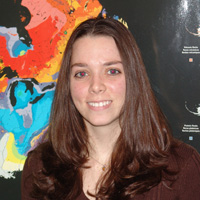 Geochemistry of the Alverson Andesite, Volcanic Hills, San Diego County, CaliforniaBriana Johnson Wednesday, May 12th, 2010 |
||
|
||
| ABSTRACT Miocene volcanic and sedimentary rocks are preserved in scattered locations along the eastern edge of the Peninsular Ranges Batholith and western Salton Trough in eastern San Diego County. These rocks include the Alverson Andesite (Diblee, 1954) and Jacumba Volcanics (Minch & Abbott, 1973). The purpose of this study is to contribute geochemical data for the Alverson Andesite, to attempt a correlation to the Jacumba Volcanics, and to relate the chemistry of the area with the tectonic setting during deposition. The focus of the study is the Alverson Andesite outcrops in the Volcanic Hills, which are located within Anza-Borrego State Park, approximately 11 km northwest of Ocotillo, California along State Highway S-2. The Volcanic Hills were studied by Fourt (1979), whose mapping and stratigraphic analysis provided the geologic framework for this geochemical study. Thirteen samples were collected from the Alverson Andesite in the Volcanic Hills from the three main volcanic stratigraphic units defined by Fourt (1979): the lower flows, volcanic mudflows, and the upper flows. The samples were analyzed for the major and trace element abundances by X-Ray Fluorescence. All of the rocks analyzed are sub-alkaline and span a composition range in SiO2 from ~49 to 62% SiO2 corresponding to basalt, basaltic-andesite, and andesite. Basalt is entirely restricted to the lower flows, which in hand sample are fine-grained with small olivine phenocrysts. Clasts from the volcanic mudflows are andesite. The upper flows are both basaltic andesite and andesite. All of these rocks plot as tholeiites on an AFM diagram. An important conclusion of this study is that basalt was erupted first, and as time progressed, the lavas were more differentiated basaltic-andesite and andesite. The nearby Jacumba Volcanics also have upper and lower flow units with basaltic lavas that were deposited first, followed by more differentiated rocks (Moses, 2007). However the similarities seem to end there, because the Jacumba Volcanics have a distinct calc-alkaline affinity compared to the Alverson Andesite. The Alverson Andesite analyses from the Volcanic Hills are also distinctly different from the Alverson Andesite outcrops in the nearby Coyote Mountains and Superstition Mountains (Gjerde, 1982). Correlating all of the different volcanic sections discussed here is difficult because of the lack of good radiometric ages. Further work is needed. References Dibblee Jr., T.W., 1954, Geology of the Imperial Valley Region, California, CDMG Part I, v. 170, p.21-28. Fourt, R., 1979, Post-Batholithic Geology of the Volcanic Hills and Vicinity, San Diego County, California: Masters of Science Thesis, San Diego State University, 66p. Gjerde, M.W., 1982, Petrography and Geochemistry of the Alverson Formation, Imperial County, California: Masters of Science Thesis,San Diego State University, 85p. Minch, J.A., Abbott, P.L., 1973, Post-Batholithic Geology of the Jacumba Area in Southeastern San Diego County, California, Transactions of the Society of Natural History, v. 17(11), p. 129-136. Moses, M.N., 2007, The Geochemistry and Petrogenesis of the Jacumba Volcanics, Jacumba, California: Senior Thesis, San Diego State University, 24p. |

